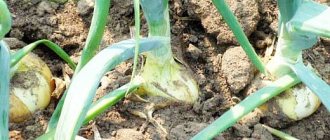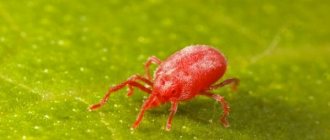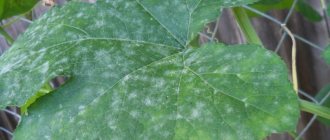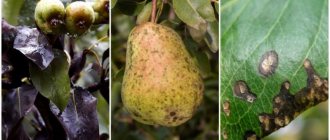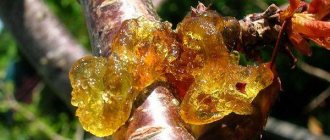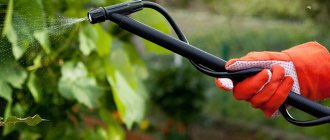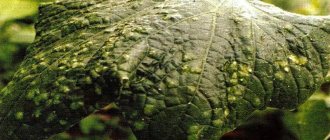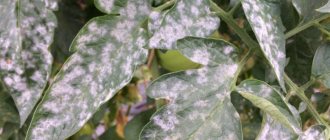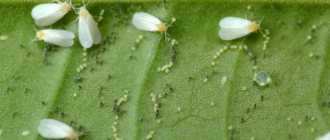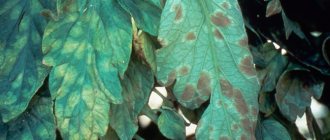Description of the pest
The potato nematode is a quarantine pest belonging to the cyst nematodes of the Heteroderidae family (different-skinned nematodes). In addition to potatoes, it affects other plants of the Solanaceae family (eggplant, tomatoes, physalis). Depending on the climate, it produces 1-2 generations per year. Reproduction is bisexual.
Roundworms are distinguished by sharp sexual dimorphism (two different forms of individuals within the same species). The female is 380–1070 µm long and 275–965 µm wide. The body color is pearly white, the shape is hemispherical or oval. During development, the color changes from white to yellow. When entering the cyst stage, the female becomes golden.
The length of the male is 890–1270 µm, width – 31–46 µm. The body is worm-shaped, narrowed at the ends.
The larva is 366–570 µm long and 18–26 µm wide. The body is narrowed on both sides.
The vital activity of adult individuals takes place inside the potato rhizome at a temperature of +15…+20°C. Males do not feed. Their main task is to find a female and fertilize her within 10 days. After this, the male dies.
One female reproduces 200–1000 eggs, which overwinter in a cyst (dead female with eggs). The cyst easily leaves the roots and remains in the soil until spring. At an air temperature of +12°C, larvae appear and infect potatoes.
One generation develops over 38–48 days. Wet weather with prolonged rains promotes intensive reproduction and development of the potato nematode.
Potato nematode
We are all accustomed to associating growing potatoes with the fight against the Colorado potato beetle; supposedly there is and cannot be a worse pest on potatoes. Chemical control agents are also mainly focused on combating the Colorado potato beetle, its larvae, and destroying the ovipositor, and in articles related to potato agricultural technology, it is the Colorado potato beetle and the fight against it that are usually mentioned.
In fact, sometimes even more dangerous than the Colorado potato beetle is the nematode; it is a very dangerous pest from which, unlike the Colorado potato beetle, it is sometimes difficult and sometimes impossible to get rid of.
Pest biology
The nematode itself is a small parasitic roundworm; its size can be considered microscopic.
Nematodes are dioecious organisms, this was discovered relatively recently; previously it was believed that the nematode was a hermaphrodite. The shape of the body of female nematodes is round; they accumulate eggs. Towards the end of the warm period, the female nematodes die, resulting in the formation of a cyst with a rather dense shell. Later, larvae emerge from the cyst.
In general, the life cycle of a nematode largely depends on the species, and soil contamination occurs over several warm seasons.
The nematode was most likely brought to our continent by accident from South America more than 100 years ago. In Russia, the nematode was first noticed around the middle of the last century and it is widespread in all regions without exception.
Types of nematodes
There are 20 species of nematodes in the world.
A number of nematode species pose a danger to potato plants:
- stem nematode,
- root-knot nematode,
- golden nematode,
- leaf nematode,
- pale nematode.
The differences between these types of nematodes are in their colors, in the way they exist, and in their habitat.
Stem nematode
It is about 1.5 mm long. It poses a serious danger to potatoes, since its larvae penetrate the stolons and tubers of potatoes and cause deformation of the stems, which literally swell; they also affect flowers and shoots. The cyst of this nematode can remain viable for up to 5 seasons; its shell is extremely durable and even elevated temperatures are not able to destroy it.
Root-knot nematode
It primarily affects the root system of potatoes. Adults in the early stages of their life are white in color, later they become transparent. Root-knot nematodes stick to the root system of plants, as a result of which swellings called galls are formed on them, hence the name nematode. Nematodes ovipositor in the galls, and later larvae.
Pallid nematode
Very similar to the golden nematode, it also forms cysts, but the color of the cysts is not yellow, but brownish-brown. This nematode infects leaf blades, which disrupts the normal course of photosynthesis processes and causes wilting of both individual leaf blades and entire bushes.
Golden nematode
Actively damages the root system, while it releases toxins that are most harmful to plants. This nematode reproduces through cysts, each of which sometimes contains up to 700 eggs.
In this type of nematode, the cysts are extremely durable; they do not die or collapse either under the influence of very high temperatures or under the influence of low temperatures, say, in winter. Even radiation and traditional insecticides are not able to destroy golden nematode cysts. Golden nematode cysts can remain viable for up to 11 years.
Cysts of the golden nematode can be found when digging up potato bushes; they are visualized as microscopic balls with a golden color, their number is sometimes very large.
| IMPORTANT If you dig up bushes and find a large number of cysts on them, you should not try to shake them off! This will only make the situation worse, and the cysts will get into the soil. |
Types of nematodes
There are several types of roundworms: golden, stem, pale, gall, leaf. Potatoes are susceptible to infection by golden nematode.
Golden
The pest penetrates the rhizome and feeds on plant juices. This makes it difficult for nutrients to reach the stems, greens and young tubers. The potato bush begins to dry from the lower leaves. Tubers are formed small or not formed at all. The rhizome is highly branched. This phenomenon is popularly called beardiness.
Males resemble tiny worms. The body of females is spherical, 384 days after fertilization it is filled with eggs. By autumn it darkens and becomes golden-brown.
The photo shows the golden potato nematode.
Stem
This worm, measuring only 1.7 mm, infects potato stems and tubers. Small dark spots are clearly visible on the infected tuber. Under the skin, areas of loose, light-colored pulp are visible. The surface becomes covered with cracks, and dry rotten rot forms underneath.
Stem nematode develops under excessive moisture. The worm parasitizes in damp cellars, crawling from tuber to tuber, infecting all planting material.
Pale
The pallid nematode has a development cycle similar to the golden nematode, differing only in color. In this case, the female’s white body acquires a brown tint.
The first signs of damage are the painful appearance of the bushes. On such plants, no more than 3 stems are formed, which turn yellow prematurely. The infection spreads upward, starting from the lower leaves, and gradually covers the entire bush.
A small number of small potatoes weighing no more than 40 g are formed on a diseased bush.
Gallovaya
The root-knot nematode attacks potato roots and tubers. It parasitizes pumpkin crops: zucchini, squash, melons, pumpkins. Lumps, sometimes growths, up to 3 cm in diameter appear on the tubers. The infected plant experiences a lack of nutrients and moisture.
Leafy
The smallest type of nematode. The length of the worm does not exceed 1 mm. The body is colorless. The pest moves inside the infected plant, provoking the addition of viral infections.
Leaf nematodes parasitize not only potatoes, but also chrysanthemums and tomatoes.
Yellowish spots appear on the leaves. Soon the greenery dries and falls off. The worm spreads through wounds on the plant.
Signs of potato nematode appearance
It is difficult to detect a nematode on a site in the early stages, which is due to the characteristics of the worms’ habitats. The main symptoms are external, based on changes in the color and shape of stems and leaves. But this happens when the parasites have already completely occupied the root system, stolons and developing potato tubers.
General signs of damage:
- yellowing of bushes for no apparent reason;
- the formation of bald spots on a potato bed (single withered brown plants appear among the green bushes);
- wilting of the lower tier of tops;
- curvature of stems;
- a small number of buds or the absence of flowering of the crop completely;
- curling of shoots.
Symptoms of golden nematode infection:
- yellowing and drying of the tops (especially the lower leaves);
- wilting of stems;
- small flowers.
The presence of a stem species in the area is signaled by deformations of potato stems: thickening, swelling. In some cases, bushes become curly. But the main symptoms are visible on the tubers:
- cracks and dark spots on potato skins;
- drying of tubers;
- loose structure.
Infection with gall worms is indicated by thickenings on the roots of bushes removed from the ground. At the same time, the plants themselves are weakened, with yellowed stems, leaves, and underdeveloped deformed tubers. It is difficult to see parasite cysts with the naked eye, so the bush is carefully dug up, trying not to shake the soil from the roots.
On a note!
To accurately determine the degree of infection, parts of plants (roots, tubers), as well as a lump of soil, are sent to specialists for examination.
Symptoms of the lesion
The danger of potato nematode lies in the hidden course of the disease. The first signs appear when the number of pests reaches a critical point. “Bald spots” appear on the potato plantation: yellow and dry bushes can be seen among the green mass. The tubers are getting smaller.
Under a magnifying glass, small round cysts resembling grains of sand are visible. They are often invisible, but at the slightest suspicion, it is better to take the wilted bush to the laboratory.
Signs of potato damage
It is not so easy to detect the pest on the site, since it lives in the underground part of plants. Typically, gardeners sound the alarm when they notice yellowing and wilting of potato bushes, deformed shoots of tops or tiny flowers. But these signs appear when the roots and tubers of the crop are infected, and the plant cannot be saved.
The fact that plantings are being damaged by an insidious worm can be recognized by the following signs:
- sudden yellowing of leaves for no apparent reason;
- deformation (swelling) of stems (stem nematode);
- wilting of the lower leaves and shoots on the bushes;
- unusually small buds and flowers.
In some cases, with severe damage, there is a lack of flowering, as well as terry tops. On the roots of dug up infected plants, thickenings (gall nematode) or numerous cyst balls (golden nematode) are visible.
On a note! If plantings are suspected of being damaged by nematode worms, specialists from regulatory authorities must be invited.
How to deal with a pest
The potato nematode is defined by the following expression: “It does not burn in fire, it does not drown in water.” It is very difficult to combat the pest; for this purpose, a whole range of measures is carried out, including agrotechnical techniques and treatment with chemicals. However, no product guarantees absolute effectiveness. Farmers in EU countries have extensive experience in combating the nematode, given that it appeared there earlier than in the Russian Federation.
Reference. If your site is located in a quarantine zone, if you follow a number of rules, you will be able to grow excellent potatoes. It is important to remember: a product from such a zone is used in cooking, but is not sold in other regions.
The final victory over the potato nematode will take more than a decade of continuous work, but the pest population can be reduced in 1-2 years.
If there are no more than 3–5 cysts per 100 cm3 of soil, there will be no harm to the potatoes. A significant decrease in yield is observed when 10–16 cysts are detected per 100 cm3 of soil.
Agrotechnical methods
To combat the pest, simple but effective agrotechnical and preventive methods are used:
- Crop rotation. Potatoes are not planted in the same area for several years in a row. Even when planting a crop in one place no more than once every 3-4 years, a serious increase in the nematode population will not occur earlier than in 40-45 years.
- Varieties resistant to the pest are planted only 3 years in a row; the next year, ordinary planting material is chosen. There is another option - to grow only crops with a high degree of protection, but change varieties every 4 years.
- In autumn, potato tops and weeds are removed from the infected area and burned, taking precautions. Working tools are disinfected with a 4% Formalin solution.
- In autumn and spring, the soil is fertilized with urea. Nitrogen is harmful to the potato nematode. If the pest spreads insignificantly in the area, they dig a hole, dump tops and weeds into it, cover everything with urea (5-6 kg/1 m3 of green mass), and sprinkle it on top with soil from a “clean” area.
- Healthy material is chosen for planting. The tubers are washed and treated with a solution of potassium permanganate (0.5 g/10 l).
- When planting, add 1 tbsp to the holes. l. bird droppings. A solution is prepared from fresh droppings in a ratio of 1:10 and the area is watered.
- Rye, beans, peas, marigolds, clover, and mustard are planted next to the beds. The roots of these plants secrete substances that are harmful to the nematode. If you sow rye on a field in the second decade, up to 90% of the larvae are destroyed, and rotted straw serves as fertilizer in the spring. Nodules containing nitrogen form on the roots of legumes. Seeds are added directly to the holes or planted between rows of potatoes.
- Ringed (earthworms) are natural enemies of nematodes. Increasing soil fertility creates favorable conditions for their reproduction.
How to fight potato nematodes?
Chemical method
When the potato nematode spreads massively, chemicals are used. Treatment is carried out 6 weeks before planting the crop, following the manufacturer’s recommendations.
To destroy nematodes, potent fungicides are used: Chloropicrin, bromomethane (methyl bromide), Nemagon. These products are released in the form of poisonous gases. They treat soil and seed material. Penetrating into the respiratory system of worms, toxins cause their death. Work is carried out wearing skin and respiratory protection.
Preparations based on organophosphorus nematicides (Lindane, Karbofos, Phosfamide) are used to eliminate stem and leaf nematodes. The prepared solutions are used to irrigate the planting material.
Important! Considering the high toxicity of agents against potato nematodes, tubers are planted in treated areas after 20–50 days.
Biological products “Basamil”, “Fitohit”, “Nematofagin BT”, “Pecilomycin” do not have a toxic effect on tubers and are effective against the pest.
Traditional methods
One of the most effective folk methods of getting rid of nematodes is pouring boiling water on the soil. No herbal infusions or decoctions will cope with the pest.
The infected area is evenly poured with boiling water to a depth of 20 cm. A plastic film is stretched over the top. This way the earth will cool down more slowly. The method destroys worms that settle only in the top layer of soil. The nematode, parasitizing in the deep layers, moves to another part of the garden.
Methods of control and treatment
The fight against potato nematodes involves various agrotechnical and chemical means. On private farms, folk methods of control give good results. The choice of method depends on the degree of soil contamination and the type of farm.
Agrotechnical
These methods are the most accessible and environmentally friendly.
These include:
- application of organic fertilizers;
- weed control;
- alternation of planted crops;
- selection of optimal dates for planting and harvesting potatoes.
Important! In areas of severe damage, it is recommended to destroy crops by digging up and further burning. Equipment and soil must be disinfected.
When growing potatoes for seed, you can use false sowings, when the planted potatoes are destroyed after the larvae have entered its root system and gone through the second stage of development. This method helps protect up to 80% of the seed material from infection.
Chemical
Plant parasitic nematodes are most vulnerable during their active phase in the soil while searching for the roots of host plants. Chemical control methods are most often used on large farms where there is special equipment and trained personnel. These include treating the soil with fumigants, which, when entering the respiratory system of the parasite, lead to its death.
Fumigants should be applied to the soil at a temperature of +12°C to +15°C since dispersion is related to temperature. Chemicals help establish a high level of control. This is especially important when growing potatoes for export.
Important! When processing with fumigants, safety precautions should be observed, since drugs in this group can be harmful to human health.
Folk remedies
People have long known how to deal with this pest. The most accessible folk remedy is to plant marigolds next to potato beds. The substances they secrete have a detrimental effect on the pest and contribute to a significant reduction in the population.
It is possible to almost completely get rid of parasites using boiling water. To do this, pour the area with hot water (not lower than +60°C) to a depth of about 20 cm. This method is used when the lesion is minor or in isolated lesions.
Potato varieties resistant to nematodes
The table shows varieties with immunity to nematodes. The root system of plants resists parasites, killing about 80% of worms.
| Name | Originator | Ripening time, days | Tuber weight, g | Productivity, c/ha |
| Limonka | Agrico | 110–120 | 75–125 | 193–315 |
| Krinitsa | RUE "Scientific and Practical Center of the National Academy of Sciences of Belarus for Potato Growing and Horticulture" | 110–120 | 88–136 | 171–280 |
| Red Scarlet | HZPC HOLLAND B.V. | 70–80 | 56–102 | 164–270 |
| Atlant | RUE "Scientific and Practical Center of the National Academy of Sciences of Belarus for Potato Growing and Horticulture" | 110–120 | 90–119 | 164–260 |
| Rosara | SAKA PFLANZENZUCHT GBR | 50–65 | 81–115 | 202–260 |
| Stonefly | RUE "Scientific and Practical Center of the National Academy of Sciences of Belarus for Potato Growing and Horticulture" | 110–120 | 93–127 | 235–368 |
| Uladar | RUE "Scientific and Practical Center of the National Academy of Sciences of Belarus for Potato Growing and Horticulture" | 50–65 | 91–140 | 127–261 |
| Lily Belarusian | RUE "Scientific and Practical Center of the National Academy of Sciences of Belarus for Potato Growing and Horticulture" | 65–70 | 102–200 | 246–407 |
| Yanka | RUE "Scientific and Practical Center of the National Academy of Sciences of Belarus for Potato Growing and Horticulture" | 90–100 | 81–106 | 195–360 |
| Zekura | Solana | 80–95 | 59–150 | 195–365 |
| Arizona | Agrico | 70–80 | 112–150 | 255–577 |
Preventive measures
As a preventive measure, the crops planted on the site should be changed. If this is not possible, varieties resistant to this pest should be periodically planted.
It is necessary to apply fertilizers on time, since strong plants are more resistant to the disease.
It should be taken into account that soil samples will show a positive result only if the soil is highly contaminated. Also, not all types of nematodes can be detected during the growing season. Therefore, preventive measures should not be neglected.
Did you know? If you harvest potatoes in 50 days, the nematode will not have time to complete its life cycle.
Potato varieties resistant to nematodes
Planting potato varieties resistant to nematodes is one of the prevention methods. There are early, mid-early and mid-late varieties.
Early:
- Rikea;
- Poran;
- Poven;
- Rosara;
- Pushkinets;
- Uladar;
- Dnepryanka;
- Felox;
- Fresco;
- League;
- Blame it;
- Al Mundo;
- Ivory Russell;
- Aksenia;
- Alova;
- Bellarosa.
Mid-early:
- Aurora;
- Rowanushka;
- Levada;
- Svitanok Kyiv;
- Dobrochin;
- Obriy.
Mid-late:
- Banafa;
- Inspiration;
- Grouse;
- Crane;
- Vectar Belarusian;
- Ruta;
- Volare;
- Lucinda;
- Ragneda;
- Sifra.
